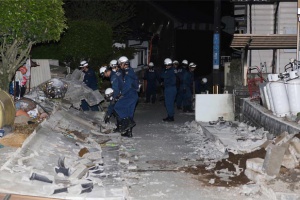Rescuers scramble for survivors after deadly quake hits Japan
General | April 15, 2016, Friday @ 08:04| 10839 views
Police officers search for victims under collapsed stone walls in the town of Mashiki, Kumamoto prefecture, early on April 15, 2016, after strong 6.4-magnitude earthquake hit Japan's southwestern island of Kyushu the day before. (JIJI PRESS / AFP)
(AFP) - Rescuers were rifling through the remains of collapsed building in southern Japan on Friday, after a powerful earthquake left at least nine people dead and injured hundreds, sparking fires and buckling roads.
Tens of thousands of people fled their homes after the 6.5-magnitude quake struck the southwestern island of Kyushu on Thursday night, leaving lumps of broken concrete strewn in the streets.
Houses collapsed, factories stopped work and a high-speed train was de-railed, while the roof of the treasured Kumamoto castle in the southern city of the same name was also damaged.
"There was a ka-boom and the whole house shook violently sideways," Takahiko Morita, a resident of nearby town Mashiki, said in a telephone interview with public broadcaster NHK.
"Furniture and bookshelves fell down, and books were all over the floor."
Dozens of aftershocks followed the quake, which hit about 9:26 pm (1226 GMT) on Thursday evening, and officials warned the death toll could rise as rescuers scoured the collapsed structures.
As rescue workers toiled through the night, an eight-month-old baby girl was pulled from the rubble alive and unharmed, NHK reported.
"As far as we can tell from infrared images from a police helicopter, there appears to be a significant number of houses destroyed or half-collapsed," said disaster minister Taro Kono.
"There are fears the number of injured could rise."
Rescuers are concentrating their searches in Mashiki, a town near the epicentre of the quake where most deaths have been recorded.
On the streets, the remains of collapsed Japanese-style houses -- many of then aged, wooden structures -- could be seen, and damaged roof tiles lay in piles.
Scores of people spent the night huddled in front of the town hall, some in tears, while others wrapped themselves in blankets to ward off the nighttime chill.
"I'm so scared of the aftershocks that I cannot sleep," 94-year-old Tomiko Takahashi told Jiji Press.
- Nuclear plants safe -
By Friday morning, the government said it had confirmed at least 860 people had been injured, at least 53 seriously. An official from the local Kumamoto disaster agency said at least nine were dead.
"We are combing through Mashiki where the damage was serious to see if there are any people who are still seeking rescue," said government spokesman Yoshihide Suga.
Gen Aoki, a Japan Meteorological Agency seismologist, urged residents to be on guard for more aftershocks and warned rain in coming days could make the situation worse.
"Please do not go near damaged houses and structures that are about to collapse," he said at an early morning briefing.
Nuclear plants in the region were unaffected, but several major manufacturers including Honda, Bridgestone, and Sony said they had suspended operations at factories in the area.
Train services on Kyushu were temporarily halted after Thursday's earthquake and a super fast bullet train derailed -- luckily while it was empty -- said Yusuke Nanri, a spokesman for operator JR Kyushu.
Some 1,600 military personnel were joined by nearly 2,000 police officers and more than 1,300 firefighters to help in the search and rescue efforts, Suga said early Friday.
The initial quake, which struck at a shallow depth of 10 kilometres (6.2 miles), was followed two and a half hours later by another measuring 6.4 magnitude, according to Japan's meteorological agency. The US Geological Survey measured it a smaller 6.2 magnitude.
In total, more than 100 earthquakes rocked the region after the first hit, and officials warned the could continue for a week or so.
Japan's two sole operating nuclear reactors, located on Kyushu, were functioning normally, an official at the Sendai plant told AFP.
Japan, one of the most seismically active countries in the world, has been particularly on edge over the vulnerability of nuclear power plants after a massive undersea quake on March 11, 2011, that sent a tsunami barrelling into the country's northeast coast.
Some 18,500 people were left dead or missing, and several nuclear reactors went into meltdown at the Fukushima plant in the worst atomic accident in a generation.
© 1994-2016 Agence France-Presse
Back
